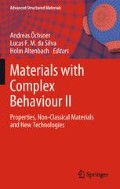Abstract
In power electronic devices the electrical connections of different components are mainly realized by heavy aluminum wire bonding. When a device heats up or cools down during use, there is a relative displacement between the first and the second contact because of differences in thermal expansion coefficients of the components and the housing of the device. This cyclic thermo mechanical loading can lead to fatigue failure of the bonding wire. Especially when placed near mechanical working components (e.g. automotive engine) additional vibrations can increase damage evolution and heating can accelerate ageing effects of the bonding wire. In the last few years there have been multiple publications presenting experimental and numerical results for high and low cycle fatigue of wire bonded devices. But all of these publications did not consider the mechanical properties of the wire in an adequate way. We present results of a micro-compression test that allows the determination of the hardening behavior parallel and perpendicular to the wire axis at moderate and large strains of small wire cylinders. The hardening behavior in compression parallel to the wire axis correlates very well to the hardening behavior determined by tensile tests at moderate strains. The hardening behavior perpendicular to the wire axis shows an anisotropic behavior of the aluminum wires depending on the drawing texture which was also analyzed by electron backscatter diffraction methods. The results for different wire materials show a dependence of the yield stress on the grain size. With the determined hardening parameters it is possible to consider the hardening of the material during the bonding process.
Access this chapter
Tax calculation will be finalised at checkout
Purchases are for personal use only
References
Scheel, W.: Baugruppentechnologie der Elektronik. Verlag Technik GmbH, Berlin (1997)
Mehrotra, V., et al.: Wirebond reliability in IGBT-power modules: application of high resolution strain and temperature mapping. International Symposium on Power Semiconductor Devices and ICs ISPSD, Toronto, pp. 113–116 (1999)
Ramminger, S., et al.: Reliability model for Al wire bonds subjected to heel crack failures. J. Microrel. 40, 1521–1525 (2000)
Wilde, J.: Lebensdauerprognose von Drahtbond-Verbindungen für die Mechatronik mittels FEM. Elektronische Baugruppen, Aufbau und Verbindungstechnik, DVS/GMM-Fachtagung, Fellbach, 40 (2002)
Dresbach, C.: Ermittlung lokaler mechanischer Kennwerte mikroelektronischer Drahtkontaktierungen. Ph.D.-thesis Martin-Luther-University Halle-Wittenberg (2010)
Hall, E.O.: The deformation and ageing of mild steel: III discussion of results. Proc. Phys. Soc. 64, 747–753 (1951)
Petch, N.J.: The cleavage strength of polycrystals. J. Iron Steel Inst. 25–28 (1953)
Hill, R.: The Mathematical Theory of Plasticity. Oxford University Press Inc., New York (1950)
Charalambides, M.N. et al.: The analysis of the frictional effect on stress—strain data from uniaxial compression of cheese. J. Mater. Sci. 365, 2313–2321 (2001)
Dresbach, C., et al.: Local hardening behavior of free air balls and heat affected zones of thermosonic wire bond interconnections. European Microelectronics and Packaging Conference EMPC, Rimini (2009)
Lemaitre, J., Chaboche, J.L: Mechanics of solid materials. Cambridge University Press, Cambridge (2002)
Dynardo: optiSLang the optimization structural language. Dynamic Software and Engineering GmbH (2008)
Author information
Authors and Affiliations
Corresponding author
Editor information
Editors and Affiliations
Rights and permissions
Copyright information
© 2012 Springer-Verlag Berlin Heidelberg
About this chapter
Cite this chapter
Altenbach, H., Dresbach, C., Petzold, M. (2012). Characterizing the Anisotropic Hardening Behavior of Aluminum Bonding Wires. In: Öchsner, A., da Silva, L., Altenbach, H. (eds) Materials with Complex Behaviour II. Advanced Structured Materials, vol 16. Springer, Berlin, Heidelberg. https://doi.org/10.1007/978-3-642-22700-4_36
Download citation
DOI: https://doi.org/10.1007/978-3-642-22700-4_36
Published:
Publisher Name: Springer, Berlin, Heidelberg
Print ISBN: 978-3-642-22699-1
Online ISBN: 978-3-642-22700-4
eBook Packages: Chemistry and Materials ScienceChemistry and Material Science (R0)

